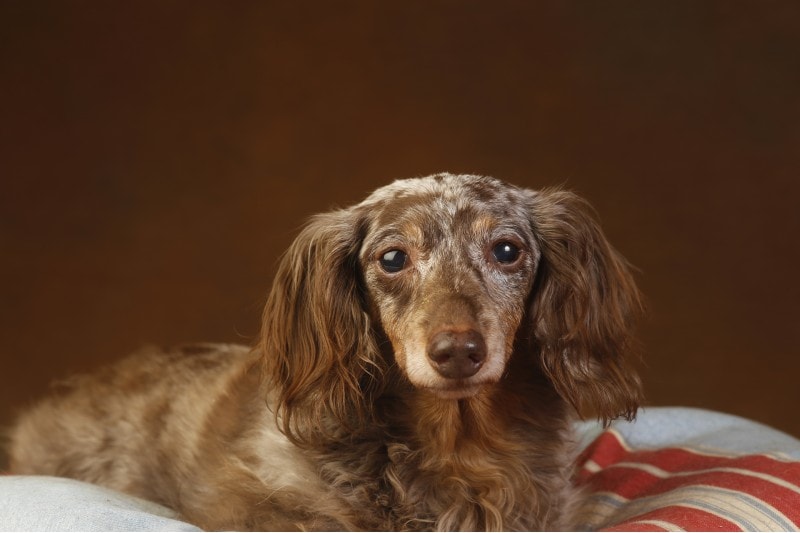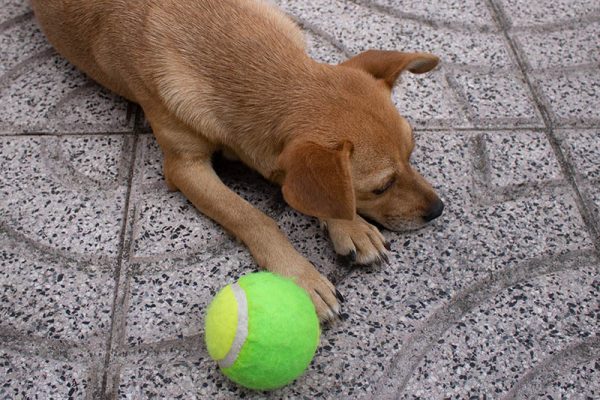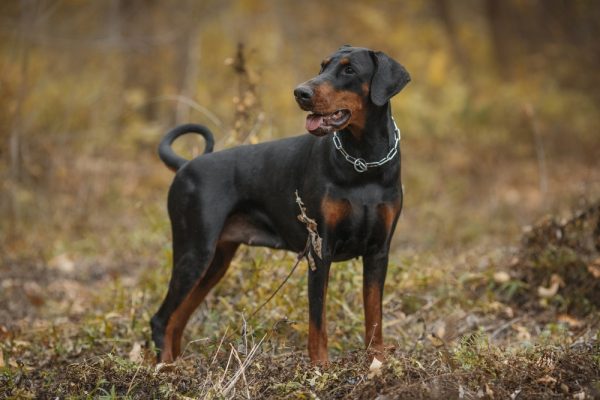Double dapple Dachshunds are a rare but beautiful coat variation of this beloved breed. The reason for the rarity is that double dapples are at a high risk of developing serious health issues because of their genetics.
Breed Overview
Height:
14–19 inches (standard); 12–15 inches (miniature)
Weight:
16–32 pounds (standard); under 11 pounds (miniature)
Lifespan:
12–16 years
Colors:
Solid red, black and tan, red and tan, merle
Suitable for:
Families with older children
Temperament:
Devoted, playful, curious
These unique Doxies are the result of breeding two dapple Dachshunds, hence the name double dapple. In this article, we’ll learn all about these unique and controversial dogs and explain why breeding them is met with such criticism.
Dachshund Characteristics

The Earliest Records of the Double Dapple Dachshund in History
The Dachshund was originally bred to hunt badgers, which is where they get their name. The word “dach” means badger, and the word “hund” means dog in German.
There is some controversy among breed experts, with the American Kennel Club stating they were first bred in the 15th century, while the Dachshund Club of America claims they were bred in the 18th century.
The first verifiable records of the breed came from books written in the 18th century, though there are also previous references to “badger dogs” and “hole dogs” long before these verifiable sources, which is likely why there is a bit of confusion over how old the breed truly is.
The breed has evolved significantly over time, with the controversial double dapple Dachshund being first introduced into the United States between 1879 and 1885.
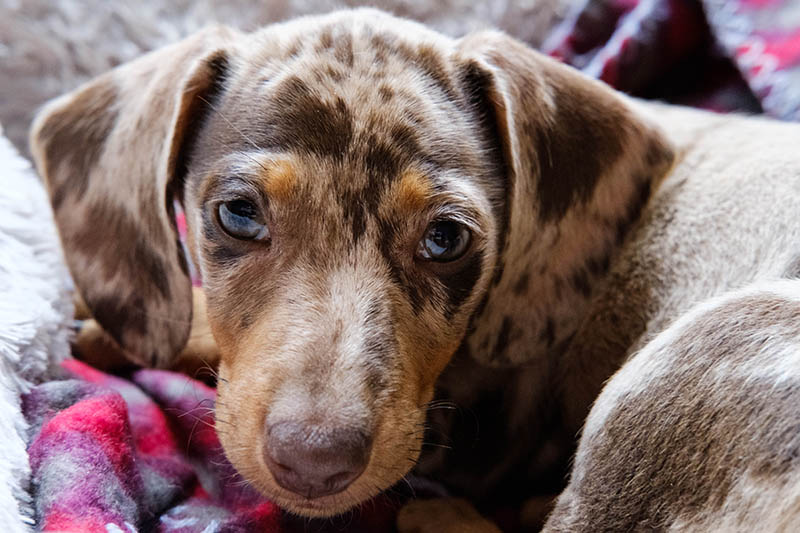
How the Double Dapple Dachshund Gained Popularity
Dachshunds have evolved significantly since they were first bred for badger hunting. The original German Dachshunds were much larger than our modern-day full-sized dachshunds. Though they’ve gone through lots of changes because of selective breeding, they still maintain their traditional scent hound traits.
Nowadays, the breed comes in two size varieties, standard and miniature, and three coat types: smooth-coated, long-haired, and wire-haired. While in the early days, they were primarily used for hunting, their role changed over time, making them one of the most popular companion breeds.
The breed was brought to the United States in the late 1800s, but its popularity didn’t begin to soar until the 1930s and 1940s. They have consistently remained a popular breed, and to this day, they rank among the top 20 most popular dog breeds in America.
Formal Recognition of the Double Dapple Dachshund
The Dachshund was first recognized by the American Kennel Club in 1885, not long after the breed made its way into the United States. As mentioned above, there are now two variations of the breed and three coat types.
The Dachshund is recognized in 15 different coat colors and 6 different marking variations, including the double dapple. Most European countries, however, forbid the double dapples due to the associated health concerns.
The Kennel Club of the United Kingdom announced that as of January 10, 2010, they would no longer accept the registration of Dachshunds that resulted from the pairing of two dapples.


Top 5 Unique Facts About Double Dapple Dachshunds
1. The Dapple Gene Is the Same as the Merle Gene
Throughout the world of purebred dogs, you’ll hear a lot about the merle coat pattern. It’s seen a wide variety of breeds like Great Danes, French Bulldogs, Shetland Sheepdogs, Corgis, and more. Interestingly, the dapple gene is the same, and Dachshunds are the only breed referred to as dapple instead of merle.

2. Double Dapples Are at Risk of Severe Genetic Health Issues
Just like it’s considered a no-no to breed two merles because of genetic health issues, the same goes for breeding two dapple dachshunds. That only makes sense, considering it’s the same gene responsible for this coat pattern.
The Dachshund breed already suffers from some concerning genetic health issues such as intervertebral disk disease, hip and elbow dysplasia, patellar luxation, and more.
Double dapples are not only at risk of these typical health concerns of the breed, but they are at a heightened risk of vision impairment or blindness, hearing impairment, or even complete deafness.
It’s not uncommon for double dapples to be both blind and deaf. In addition to these issues, their lack of pigment makes them more sensitive to sun exposure and can cause an increased risk of skin damage and skin cancer.
3. Dapple Is Not a Color But a Coat Pattern
Dapple is used to describe the spotting seen on the dachshund’s coat; therefore, it is considered a coat pattern rather than a coat color. There can be many color varieties of dapple, with the most common being a blue coat color combined with gray, black, brown, and tan.
Most often, the double dapples have blue eyes and exhibit lots of white within the coat, with some being predominantly white. When two dapples are bred, the probability of puppies receiving the double dapple gene is approximately 25%.

4. All Double Dapples Come in Two Size Varieties and Three Coat Types
Double dapple Dachshunds are not limited to any size variety or coat type. They can be either miniature or standard size and have smooth coats, long hair, or wirehaired. All these physical attributes were achieved through selective breeding over the years.
5. Dachshunds Have a Form of Dwarfism
The gene responsible for a Dachshund’s short legs and unique body shape is the same gene responsible for dwarfism. This gene is called chondrodysplasia but is also referred to as canine dwarfism. This gene occurs naturally in many other long-bodied, short-legged breeds, including Corgis, Basset Hounds, and Beagles.
Chondrodystrophy is the abnormal development of cartilage, which causes the long bones of the body to grow at an abnormally slow rate, resulting in shortened legs. It is associated with genetic health conditions like intervertebral disc disease and also elbow and hip dysplasia.
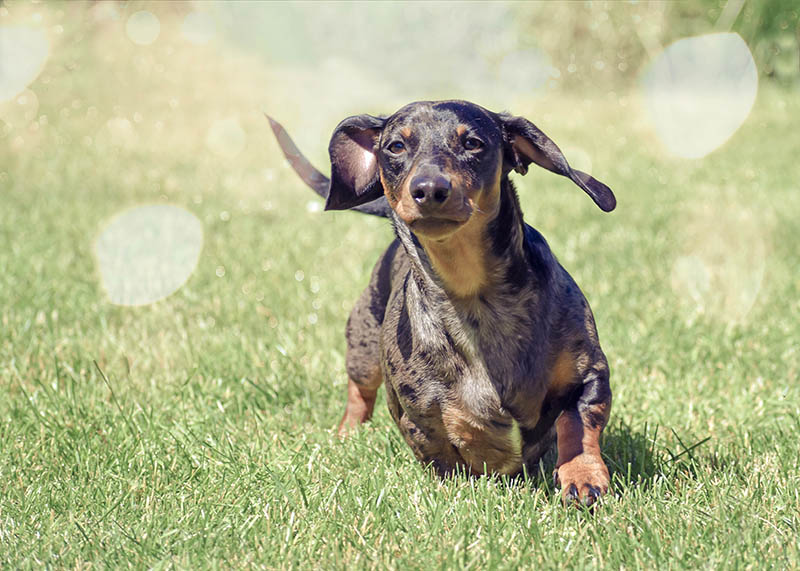

Do Double Dapple Dachshunds Make Good Pets?
As with any breed, the Dachshund has unique characteristics that may or may not be compatible with a person’s lifestyle. The breed requires about an hour of mild exercise per day to keep them physically fit and mentally stimulated.
Dachshunds have a high prey drive that comes from their hunting origins, and they also love to bark a lot. They are very devoted to their people and require a lot of attention. They typically do well with children if they are raised together or are properly socialized at an early age.
Dachshunds do have a stubborn streak, so training can be more difficult and requires a lot of patience. They are known for being particularly stubborn with potty training, which is something to keep in mind.
It’s recommended that you feed a Dachshund a high-quality, nutritious diet and avoid overfeeding, as they commonly suffer from obesity. Their grooming needs to depend on which coat type you have, with smooth-haired versions being the least maintenance.
Double dapples who suffer from deafness, blindness, or any impairments will be considered special needs, which require a lot of attention and specific care requirements. Overall, these lovely little dogs are very lively, clever, and playful, and there’s a reason why they are beloved by so many.

Final Thoughts
Double dapple Dachshunds are the result of breeding two dapples together. This unique and beautiful coat pattern comes with some serious genetic health risks, most commonly deafness and blindness. While the coat is recognized by the AKC, it is frowned upon to breed double dapples and is banned across Europe. Though they may be controversial, they are still lovely little animals with a lot to offer.
Featured Image Credit: a katz, Shutterstock
